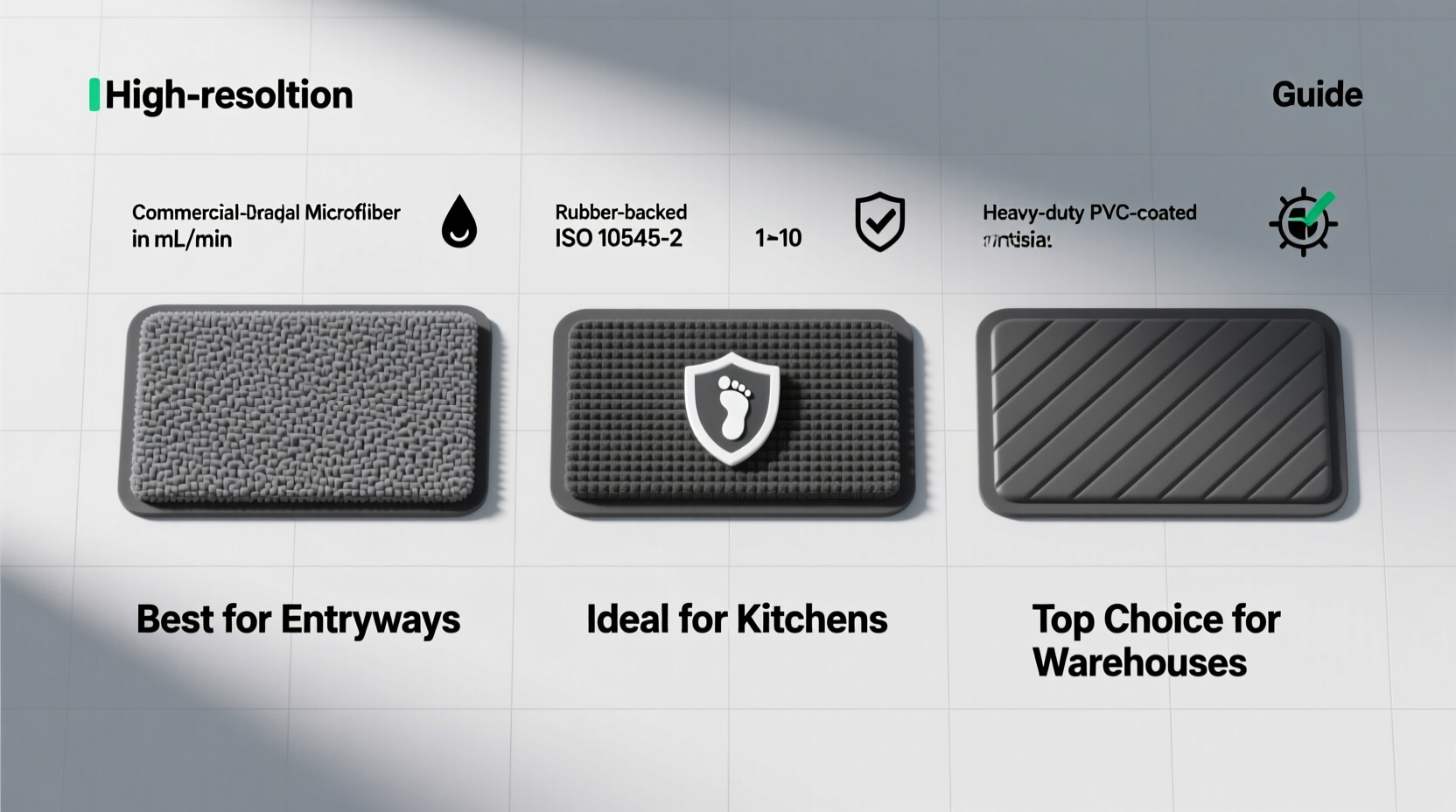In commercial buildings, retail spaces, hospitals, schools, and even high-traffic residential entries, the right absorbent mat can make a significant difference in safety, cleanliness, and long-term floor maintenance. These mats are not just decorative—they serve as the first line of defense against dirt, moisture, and debris tracked indoors. However, not all mats perform equally under heavy foot traffic. Choosing one that balances durability, absorption capacity, and ease of maintenance is essential. This guide breaks down what to look for when selecting an absorbent mat that will stand up to constant use without compromising effectiveness.
Understand the Role of Absorbent Mats in High-Traffic Zones

Absorbent mats in high-traffic areas do more than catch water from wet shoes. They reduce slip-and-fall risks, protect flooring from abrasion caused by grit, and lower cleaning costs by trapping contaminants at the source. In environments like grocery stores, lobbies, or hospital entrances, where hundreds or thousands of people pass daily, a poorly performing mat can quickly become saturated, dislodged, or torn—rendering it ineffective and potentially hazardous.
The best mats act as filtration systems: they scrape, trap, and retain moisture and particulates before they spread across interior surfaces. To fulfill this role consistently, the mat must be engineered for resilience and efficiency, not just appearance.
Key Features of Durable and Effective Absorbent Mats
Selecting the right mat requires evaluating several interdependent factors: material composition, construction method, backing type, and surface design. Each plays a critical role in longevity and functionality.
1. Material Composition
The fabric or fiber used determines how well the mat absorbs moisture and resists wear. Common materials include:
- Nylon: Highly durable, mold-resistant, and excellent at wicking moisture. Ideal for heavy-duty applications but can be expensive.
- Polypropylene: Affordable, colorfast, and resistant to mildew. Less absorbent than nylon but performs well in moderate traffic zones.
- Cotton blends: Soft and highly absorbent but prone to fraying and shrinking with frequent washing. Better suited for low-traffic interiors.
- Rubber or PVC-backed textiles: Combine absorbent tops with non-slip bases, making them ideal for entrances with tile or hardwood floors.
2. Construction and Weave Density
Tightly woven or looped fibers hold more moisture and resist mat deformation. Look for mats labeled “high-density” or “commercial-grade.” Cut-pile designs may feel plush but tend to flatten faster under pressure. Conversely, scraper-style mats with rigid nubs excel at removing mud and snow but offer less absorption.
3. Backing Type
A secure, non-slip backing prevents shifting and curling—a common hazard in busy corridors. Rubber or vinyl backings provide superior grip on smooth surfaces. For carpeted entries, consider skid-resistant coatings or gripper pads underneath.
“Mats that move or bunch create tripping hazards and lose their effectiveness within days. A stable base is non-negotiable in high-traffic settings.” — James Reed, Facility Safety Consultant, National Floor Safety Institute
Comparison of Common Mat Types for High-Traffic Use
| Mate Type | Absorption Level | Durability | Best For | Lifespan (Avg.) |
|---|---|---|---|---|
| Heavy-Duty Nylon Scraper | Moderate | Very High | Outdoor entrances, industrial sites | 5–7 years |
| Polypropylene Indoor/Outdoor | High | High | Shopping malls, office lobbies | 3–5 years |
| Rubber Coated Wiper | Low-Moderate | Very High | Subway stations, garages | 6+ years |
| Cotton Loop Pile | Very High | Low-Moderate | Hotel rooms, restrooms | 1–2 years |
| Aluminum Tread Plate | None (drains) | Extreme | Airports, transit hubs | 10+ years |
Step-by-Step Guide to Selecting the Right Mat
Finding the optimal absorbent mat involves more than browsing product catalogs. Follow this practical process to ensure your selection meets operational demands.
- Assess Traffic Volume and Type: Estimate daily footfall. Is it primarily pedestrians, carts, or wheeled equipment? High turnover (e.g., supermarkets) demands reinforced edges and industrial stitching.
- Evaluate Environmental Exposure: Will the mat face rain, snow, or sand? Outdoor-facing mats need UV resistance and drainage capabilities.
- Determine Required Dimensions: The mat should cover the full width of the entrance and allow at least three full steps. A minimum of 6 feet in length is recommended; 10–12 feet is ideal.
- Check Maintenance Protocols: Can the mat be machine-washed? Vacuumed? Hosed down? Facilities without laundry access should prioritize low-maintenance options.
- Verify Safety Compliance: Ensure the mat meets ADA guidelines for slip resistance and trip hazards. Look for certifications like ANSI/BHMA A156.3 for commercial hardware.
- Request Samples: Test small sections under real conditions for a week. Monitor for fading, warping, and moisture retention.
Real-World Example: Improving Lobby Cleanliness in a Medical Center
A regional medical clinic in Portland, Oregon, struggled with muddy tile floors during winter months despite daily mopping. Patient satisfaction scores cited slippery conditions as a concern. After auditing foot traffic and weather patterns, the facility manager replaced thin cotton welcome mats with 10-foot polypropylene walk-off mats featuring rubber backing.
Within two weeks, janitorial staff reported a 60% reduction in floor cleaning time. The new mats absorbed standing water from boots and scraped off compacted snow. Over six months, incident reports related to slips dropped to zero. The initial investment paid for itself in reduced labor and improved patient safety.
Essential Checklist Before Purchasing
- ✅ Measures at least 6 feet in the direction of travel
- ✅ Made from commercial-grade, fade-resistant material
- ✅ Features non-slip, waterproof backing
- ✅ Resistant to mold, mildew, and bacterial growth
- ✅ Easy to clean—vacuumable, washable, or hose-rinsable
- ✅ Complies with local safety and accessibility standards
- ✅ Color contrasts with floor to enhance visibility and aesthetics
- ✅ Includes reinforced edging to prevent fraying
Frequently Asked Questions
How often should absorbent mats in high-traffic areas be cleaned?
Daily vacuuming is recommended to remove dry soil. Deep cleaning—via shampooing, hosing, or laundering—should occur weekly in very busy locations, or biweekly in moderate-use areas. Immediate cleaning is necessary if visibly soiled or saturated.
Can one mat work for both indoor and outdoor use?
Some dual-sided mats are designed for transitional zones. These typically have a scraper grid on the outside half and an absorbent textile on the inside. However, placing any fabric mat fully outdoors risks rapid degradation from sun exposure and pooling water. Always use exterior-rated mats outside and transition to indoor-absorbent types just beyond the threshold.
Are more expensive mats always better?
Not necessarily. While premium materials like solution-dyed nylon offer superior longevity, budget-friendly polypropylene mats can deliver excellent value when properly sized and maintained. Focus on performance specifications rather than price alone.
Final Recommendations and Action Steps
Choosing the right absorbent mat isn’t about picking the thickest or most colorful option—it’s about matching function to environment. Prioritize structural integrity, proper sizing, and maintenance feasibility over aesthetics. Invest in commercial-grade products even if they cost more upfront; their extended service life and reduced risk of accidents justify the expense.
Start by mapping your building’s main entry points and assessing usage patterns. Then apply the checklist and comparison insights provided here to narrow your choices. Whenever possible, pilot test a mat before rolling out site-wide installations. Small adjustments in mat selection can lead to major improvements in cleanliness, safety, and operational efficiency.









 浙公网安备
33010002000092号
浙公网安备
33010002000092号 浙B2-20120091-4
浙B2-20120091-4
Comments
No comments yet. Why don't you start the discussion?